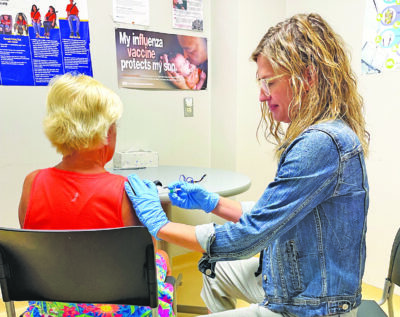
Nurse Liz of the Clay County Health Department administers a vaccination to a Moorhead resident. (Photo/Submitted)
Nancy Edmonds Hanson
The rate of childhood immunizations is slipping in Minnesota – down about 5% over the past five years. That concerns Rebecca Schmidt, an epidemiologist with Clay County Public Health.
“We are victims of our own success,” she says. “In past generations, parents were familiar with the diseases that are common in childhood like chicken pox, mumps and measles. They’d experienced them firsthand.
“Generation Now’s parents don’t have those recollections. They had been largely prevented by nearly universal vaccinations required before kids started school. Vaccines have done their job so well that, until now, even many doctors practicing today have never seen a case of measles.”
Until now. The outbreak of measles in the Twin Cities, while just 36 cases reported through Monday, has sent a stark message to those who work in public health: The diseases that today’s grandparents knew well are still around, and those who are unvaccinated are totally vulnerable.
“Measles is one you do not want to mess with,” Becky emphasizes. “One in three of the cases in the Twin Cities this summer has had to be hospitalized. There can be a lot of serious complications like pneumonia, encephalitis and even death, and it’s highly, highly contagious.”
Minnesota law requires written proof that every child entering school has been immunized against seven diseases, including diphtheria, tetanus, pertussis (whooping cough), measles, mumps, rubella and polio. The first six are included in two injections – DTaP and MMR. Exemptions can be requested for medical reasons or based on the parents’ or guardians’ beliefs.
The number of Minnesota kindergartners who have received the MMR and DTaP has diminished from about 94% in the 2019-2020 school year to 87% in 2023-2024. Other vaccinations considered essential are also down in comparable numbers across the state, including varicella (chickenpox); Hepatitis B; and tetanus, diphtheria and whooping cough.
“If you don’t get the vaccines in childhood, the diseases can be much worse as adults,” she says. “Chickenpox and mumps are generally mild at younger ages but can be quite serious for adults. Rubella can be very severe, especially for pregnant women, whose babies may be born with physical and mental disabilities. Yet the MMR and varicella vaccines are very, very safe and effective.”
The falling rate of vaccinations is generally attributed to controversy over COVID-19 vaccines. Several celebrities have also raised unfounded claims about a link between autism and vaccines. While there is no evidence to support rampant rumors of their dangers, that suspicion is presumed to have slipped over vaccinations in general.
Skipping vaccinations affects not only the children who are left vulnerable but everyone around them. Some are more vulnerable, including the very young, the very old, and those whose immune systems are compromised by disease or medical treatment.
“We say herd immunity requires a vaccination rate of about 90 to 95%,” Becky explains. “These microbes are smart. Some are more contagious than others and spread more easily.” She illustrates her point with the measles virus: Expelled by coughing or simply breathing, the virus particles float in the air for up to two hours.
By getting the shots, she adds, “You’re doing more than protecting yourself. You’re protecting your friends and neighbors.”
That brings the conversation to influenza and its still-mysterious cousin, COVID-19. While COVID rates spiked again this summer, the rate of vaccinations with the latest booster shots has fallen dramatically. The state health department reports that only 14.1% of Minnesotans are up to date on their vaccinations. The newest COVID booster will be available this month.
Becky strongly advocates vaccinations, for not only children, but also adults. “Other than COVID, people haven’t seen these terrible diseases for years and years. Their fear has shifted to fear of vaccines themselves,” the epidemiologist points out. “Other than a little pain at the injection site and, at worst, brief faintness, there is nothing to worry about. The diseases are far, far worse than the prevention.”
More information on vaccinations for children and adults is available from Clay County Public Health, https://claycountymn.gov/529/Immunizations.



